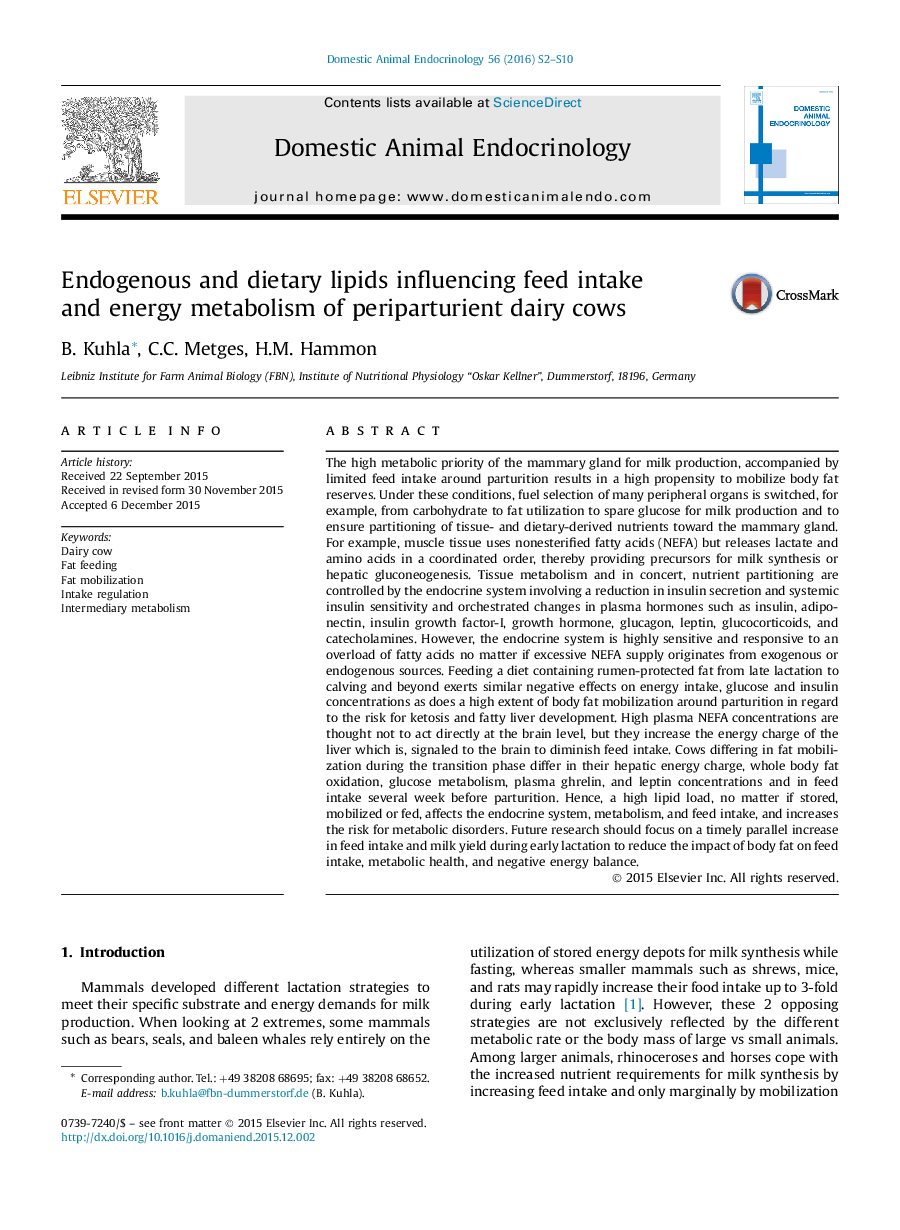| کد مقاله | کد نشریه | سال انتشار | مقاله انگلیسی | نسخه تمام متن |
|---|---|---|---|---|
| 10961138 | 1101316 | 2016 | 9 صفحه PDF | دانلود رایگان |
عنوان انگلیسی مقاله ISI
Endogenous and dietary lipids influencing feed intake and energy metabolism of periparturient dairy cows
ترجمه فارسی عنوان
چربی های اندوژن و رژیم غذایی بر میزان مصرف غذا و متابولیسم انرژی در گاوهای شیری
دانلود مقاله + سفارش ترجمه
دانلود مقاله ISI انگلیسی
رایگان برای ایرانیان
کلمات کلیدی
گاو شیری، تغذیه چربی، بسیج چربی، مقررات ورودی، متابولیسم واسطه
موضوعات مرتبط
علوم زیستی و بیوفناوری
علوم کشاورزی و بیولوژیک
علوم دامی و جانورشناسی
چکیده انگلیسی
The high metabolic priority of the mammary gland for milk production, accompanied by limited feed intake around parturition results in a high propensity to mobilize body fat reserves. Under these conditions, fuel selection of many peripheral organs is switched, for example, from carbohydrate to fat utilization to spare glucose for milk production and to ensure partitioning of tissue- and dietary-derived nutrients toward the mammary gland. For example, muscle tissue uses nonesterified fatty acids (NEFA) but releases lactate and amino acids in a coordinated order, thereby providing precursors for milk synthesis or hepatic gluconeogenesis. Tissue metabolism and in concert, nutrient partitioning are controlled by the endocrine system involving a reduction in insulin secretion and systemic insulin sensitivity and orchestrated changes in plasma hormones such as insulin, adiponectin, insulin growth factor-I, growth hormone, glucagon, leptin, glucocorticoids, and catecholamines. However, the endocrine system is highly sensitive and responsive to an overload of fatty acids no matter if excessive NEFA supply originates from exogenous or endogenous sources. Feeding a diet containing rumen-protected fat from late lactation to calving and beyond exerts similar negative effects on energy intake, glucose and insulin concentrations as does a high extent of body fat mobilization around parturition in regard to the risk for ketosis and fatty liver development. High plasma NEFA concentrations are thought not to act directly at the brain level, but they increase the energy charge of the liver which is, signaled to the brain to diminish feed intake. Cows differing in fat mobilization during the transition phase differ in their hepatic energy charge, whole body fat oxidation, glucose metabolism, plasma ghrelin, and leptin concentrations and in feed intake several week before parturition. Hence, a high lipid load, no matter if stored, mobilized or fed, affects the endocrine system, metabolism, and feed intake, and increases the risk for metabolic disorders. Future research should focus on a timely parallel increase in feed intake and milk yield during early lactation to reduce the impact of body fat on feed intake, metabolic health, and negative energy balance.
ناشر
Database: Elsevier - ScienceDirect (ساینس دایرکت)
Journal: Domestic Animal Endocrinology - Volume 56, Supplement, July 2016, Pages S2-S10
Journal: Domestic Animal Endocrinology - Volume 56, Supplement, July 2016, Pages S2-S10
نویسندگان
B. Kuhla, C.C. Metges, H.M. Hammon,
